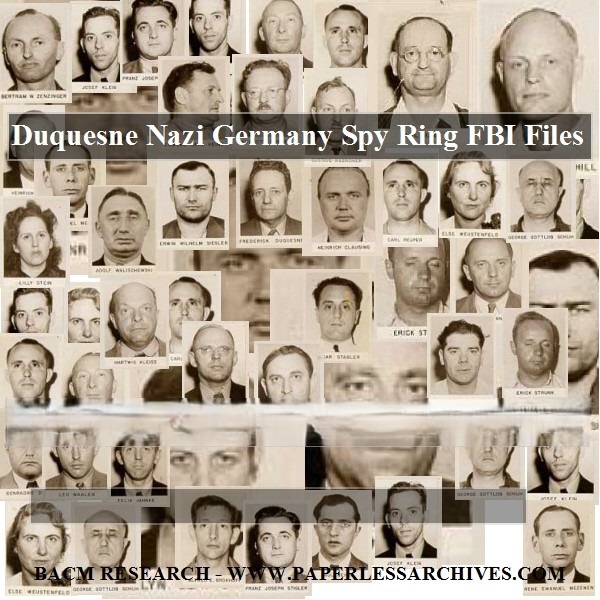
Duquesne Nazi Germany Spy Ring FBI & MI6 Files
$19.50
Description
The Duquesne Spy Ring: A Timeline and Cast
Timeline of Events: The Duquesne Spy Ring
Pre-1914:
- Boer War: Fritz Joubert Duquesne comes to the attention of British intelligence during the Boer War (1899-1902).
1915 – 1918:
- January 1, 1915 – December 31, 1945: Period covered by MI5 files related to Fritz Joubert Duquesne.
- February 18, 1916: The British ship ‘Tennyson’ is bombed and sunk. British intelligence later reports that Duquesne was behind this act.
- November 17, 1917: Fritz Joubert Duquesne is arrested in New York City while masquerading as an Australian. He possesses news clippings about ship explosions and a letter from the Assistant German Vice Consul in Nicaragua, indicating his service to the German cause.
- 1918: British intelligence attempts to have Duquesne extradited from the United States to the United Kingdom. German intelligence is reported to have arranged Duquesne’s Australian identity.
1921:
- William Sebold leaves Germany.
1921 – 1936:
- William Sebold works in industrial and aircraft plants throughout the United States and South America.
February 1936:
- William Sebold becomes a naturalized citizen of the United States.
February 1939:
- William Sebold returns to Germany to visit his mother in Mulheim. Upon arrival in Hamburg, he is approached by a member of the Gestapo who informs him he will be contacted soon.
September 1939:
- A Dr. Gassner visits William Sebold in Mulheim. He interrogates Sebold about military planes and equipment in the United States and asks him to return to the US as a German espionage agent.
- Sebold’s passport is stolen shortly after Dr. Gassner’s initial visit.
Late 1939 – Early 1940:
- William Sebold is visited multiple times by Dr. Gassner and “Dr. Renken” (later identified as Major Nickolaus Ritter of the German Secret Service). They persuade him to cooperate with Germany due to fears of reprisal against his family.
- Sebold goes to the American Consulate in Cologne, Germany, to obtain a new passport. He secretly informs consulate personnel about his recruitment as a German agent and his intention to cooperate with the FBI.
- Sebold reports to Hamburg, Germany, for espionage training, including preparing coded messages and microphotographs. He receives five microphotographs with instructions for coding and the type of information to transmit. He is instructed to deliver three of these to German operatives in the US.
- Sebold receives final instructions, including the alias “Harry Sawyer,” and sails from Genoa, Italy.
February 8, 1940:
- William Sebold, under the alias Harry Sawyer, arrives in New York City. The FBI has been informed of his arrival, mission, and intention to cooperate.
Post-February 8, 1940:
- Under FBI guidance, Sebold establishes residence in New York City as Harry Sawyer.
- An office is established for Sebold as a consultant diesel engineer, serving as a cover for meeting with spy ring members. The FBI selects an office that allows for surveillance.
- May 1940: A shortwave radio transmitting station operated by FBI agents on Long Island establishes contact with a German shortwave station abroad. This becomes the primary communication channel between German spies in New York and their superiors in Germany for 16 months. Over 300 messages are transmitted to Germany and 200 received.
- William Sebold (as Harry Sawyer) contacts Frederick Joubert Duquesne by letter and subsequently meets him in Duquesne’s “Air Terminals Company” office in New York City.
- During their initial meeting, Duquesne expresses concern about surveillance and suggests they talk elsewhere. They relocate to an Automat and exchange information about German espionage contacts.
- Sebold and Duquesne continue to meet, including at Sebold’s FBI-monitored office. These meetings are filmed by the FBI.
- Duquesne provides Sebold with information related to US national defense, ship movements to British ports, and technology, which is then transmitted to Germany via the FBI’s radio station. Duquesne receives payments from Germany for his services.
- Duquesne provides Sebold with photographs and specifications of a new US bomb, claiming to have obtained them by secretly entering the DuPont plant in Wilmington, Delaware.
- Duquesne also explains methods for starting fires in industrial plants.
- Duquesne gathers information by posing as a student and corresponding with industrial concerns to request data on their products and manufacturing processes.
January 2, 1942:
- 33 members of the Nazi spy ring headed by Frederick Joubert Duquesne are sentenced to a total of over 300 years in prison.
- Frederick Joubert Duquesne is sentenced to 18 years in prison for espionage charges, a concurrent 2-year sentence, and a $2,000 fine for violation of the Registration Act.
Post-January 2, 1942:
- The FBI continues to process information and close cases against the members of the spy ring.
December 31, 1945:
- The end date of the period covered by the MI5 files related to Fritz Joubert Duquesne.
Cast of Characters:
- Frederick Joubert Duquesne: Born in Cape Colony, South Africa. Emigrated to the US in 1902 and became a US citizen in 1913. Head of the Nazi spy ring in the United States. Had a long history of involvement in German intelligence activities, dating back to the Boer War and including involvement in the bombing of the British ship ‘Tennyson’ in 1916. Operated a business called “Air Terminals Company.” Convicted of espionage and sentenced to 18 years in prison.
- William Sebold (alias Harry Sawyer): A native of Germany who served in the German army during World War I. Lived and worked in the US and South America before becoming a US citizen in 1936. Recruited by the Gestapo in Germany in 1939 to become a spy. Secretly contacted the American Consulate and agreed to work as a double agent for the FBI upon his return to the US. Played a crucial role in the FBI’s successful investigation by establishing contact with and gathering information from members of the spy ring under the alias “Harry Sawyer.”
- Dr. Gassner: A member of the Gestapo who initially approached William Sebold in Germany in September 1939 and interrogated him about US military information, recruiting him as a spy.
- Dr. Renken (Major Nickolaus Ritter): A Major in the German Secret Service who, along with Dr. Gassner, persuaded William Sebold to cooperate with German intelligence.
- Paul Bante: A member of the Duquesne spy ring.
- Max Blank: A member of the Duquesne spy ring.
- Alfred E. Brokhoff: A member of the Duquesne spy ring.
- Heinrich Clausing: A member of the Duquesne spy ring.
- Conradin Otto Dold: A member of the Duquesne spy ring.
- Rudolf Ebeling: A member of the Duquesne spy ring.
- Richard Eichenlaub: A member of the Duquesne spy ring.
- Heinrich Carl Eilers: A member of the Duquesne spy ring.
- Paul Fehse: A member of the Duquesne spy ring.
- Edmund Carl Heine: A member of the Duquesne spy ring.
- Felix Jahnke: A member of the Duquesne spy ring.
- Gustav Wilhelm Kaercher: A member of the Duquesne spy ring.
- Josef Klein: A member of the Duquesne spy ring.
- Hartwig Richard Kleiss: A member of the Duquesne spy ring.
- Herman W. Lang: A member of the Duquesne spy ring.
- Evelyn Clayton Lewis: A member of the Duquesne spy ring.
- Rene Emanuel Mezenen: A member of the Duquesne spy ring.
- Carl Reuper: A member of the Duquesne spy ring.
- Everett Minster Rpede: A member of the Duquesne spy ring.
- Paul Scholz: A member of the Duquesne spy ring.
- George Schuh: A member of the Duquesne spy ring.
- Erwin Siegler: A member of the Duquesne spy ring.
- Oscar Stabler: A member of the Duquesne spy ring.
- Heinrich Stade: A member of the Duquesne spy ring.
- Lilly Stein: A member of the Duquesne spy ring.
- Franz Stigler: A member of the Duquesne spy ring.
- Erich Strunck: A member of the Duquesne spy ring.
- Leo Waalen: A member of the Duquesne spy ring.
- Adolf Walischewski: A member of the Duquesne spy ring.
- Else Weustenfeld: A member of the Duquesne spy ring.
- Axel Wheeler-Hill: A member of the Duquesne spy ring.
- Bert Zenzinger: A member of the Duquesne spy ring.
Duquesne Nazi Germany Spy Ring FBI & MI6 Files
2,966 pages of FBI and British intelligence files covering the Duquesne Spy Ring.
On January 2, 1942, 33 members of a Nazi spy ring headed by Frederick Joubert Duquesne were sentenced to serve a total of over 300 years in prison. William Sebold, who had been recruited as a spy for Germany, was a major factor in the FBI’s successful resolution of this case through his work as a double agent for the United States.
FBI Files include:
Background information on each member of the spy ring. Detailed chronology of events. Information on the disposition of the cases against each member of the spy ring. Sworn affidavits of Frederick Joubert Duquesne. Sworn affidavits of other members of the spy group. Transcripts of letters found in Duquesne’s apartment. Transcripts of interviews with other members of the spy ring. Listings of findings from searches of the homes and apartments of spy ring members. Information obtained from bugging. Radio messages sent and received from the Bureau’s station at Centerport, Long Island.
MI5 files
304 pages of MI5 documents related to Fritz Joubert Duquesne dating from 1915 Jan 01 to 1945 Dec 31. Covers Duquesne being arrested in New York in 1918 masquerading as an Australian whose identity, it was reported, had been arranged by German intelligence. Duquesne came to the attention of British intelligence during Boer War. File contains report of bombing of British ship ‘Tennyson’ which Duquesne was behind, a report confirming Duquesne a German intelligence officer and group photo featuring Duquesne. Files show that in 1918 the British attempted to have Duquesne extradited from the United States to the United Kingdom
History of the Spy Ring
A native of Germany, William Sebold served in the German army during World War I. After leaving Germany in 1921, he worked in industrial and aircraft plants throughout the United States and South America. On February 1936 he became a naturalized citizen of the United States.
Sebold returned to Germany in February 1939, to visit his mother in Mulheim. Upon his arrival in Hamburg, Germany, he was approached by a member of the Gestapo who said that Sebold would be contacted in the near future. In September 1939, a Dr. Gassner visited Sebold in Mulheim and interrogated him regarding military planes and equipment in the United States. He also asked Sebold to return to the United States as an espionage agent for Germany. Subsequent visits by Dr. Gassner and a “Dr. Renken,” later identified as Major Nickolaus Ritter of the German Secret Service, persuaded Sebold to cooperate with the Reich because he feared reprisals against family members still living in Germany.
Since Sebold’s passport had been stolen shortly after his first visit from Dr. Gassner, Sebold went to the American Consulate, in Cologne, Germany, to obtain a new one. While doing so, Sebold secretly told personnel of the American Consulate about his future role as a German agent and expressed his wish to cooperate with the FBI upon his return to America. Sebold reported to Hamburg, Germany, where he was instructed in such areas as preparing coded messages and microphotographs. Upon completion of training, he was given five microphotographs containing instructions for preparing a code and detailing the type of information he was to transmit to Germany from the United States. Sebold was told to retain two of the microphotographs and to deliver the other three to German operatives in the United States. After receiving final instructions, including using the assumed name “Harry Sawyer,” he sailed from Genoa, Italy, and arrived in New York City on February 8, 1940.
The FBI previously had been advised of Sebold’s expected arrival, his mission and his intentions to assist them in identifying German agents in the United States. Under the guidance of Special Agents, Sebold established residence in New York City as Harry Sawyer. Also, an office was established for him as a consultant diesel engineer, to be used as a cover in establishing contacts with members of the spy ring. In selecting this office for Sebold, FBI agents ensured that they could observe any meetings taking place there. In May 1940, a shortwave radio transmitting station operated by FBI Agents on Long Island established contact with a German shortwave station abroad. This radio station served as a main channel of communication between German spies in New York City and their superiors in Germany for 16 months. During this time, the FBI’s radio station transmitted over 300 messages to Germany and received 200 messages from Germany.
Frederick Joubert Duquesne was born in Cape Colony, South Africa, on September 21, 1877, Frederick Joubert Duquesne emigrated from Hamilton, Bermuda, to the United States in 1902 and became a naturalized United States citizen on December 4, 1913. Duquesne was implicated in fraudulent insurance claims, including one that resulted from a fire aboard the British steamship Tennyson, which caused the vessel to sink on February 18, 1916. When he was arrested on November 17, 1917, he had in his possession a large file of news clippings concerning bomb explosions on ships, as well as a letter from the Assistant German Vice Consul at Managua, Nicaragua. The letter indicated that “Captain Duquesne” was “one who has rendered considerable service to the German cause.”
When Sebold returned to the United States in February 1940, Duquesne was operating a business known as the “Air Terminals Company” in New York City. After establishing his first contact with Duquesne by letter, Sebold met with him in Duquesne’s office. During their initial meeting, Duquesne, who was extremely concerned about the possibility of electronic surveillance devices being present in his office, gave Sebold a note stating that they should talk elsewhere. After relocating, to an Automat, the two men exchanged information about members of the German espionage system with whom they had been in contact. Duquesne provided Sebold with information for transmittal to Germany during subsequent meetings, and the meetings which occurred in Sebold’s office were filmed by FBI Agents. Duquesne, who was vehemently anti-British, submitted information dealing with national defense in America, the sailing of ships to British ports and technology. He also regularly received money from Germany in payment for his services.
On one occasion, Duquesne provided Sebold with photographs and specifications of a new type of bomb being produced in the United States. He claimed that he secured that material by secretly entering the DuPont plant in Wilmington, Delaware. Duquesne also explained how fires could be started in industrial plants. Much of the information Duquesne obtained was the result of his correspondence with industrial concerns. Representing himself as a student, he requested data concerning their products and manufacturing conditions.
Duquesne was brought to trial and was convicted. He was sentenced to serve 18 years in prison on espionage charges, as well as a 2-year concurrent sentence and payment of a $2,000 fine for violation of the Registration Act.
Other members of the spy group included: Paul Bante, Max Blank, Alfred E. Brokhoff, Heinrich Clausing, Conradin Otto Dold, Rudolf Ebeling, Richard Eichenlaub, Heinrich Carl Eilers, Paul Fehse, Edmund Carl Heine, Felix Jahnke, Gustav Wilhelm Kaercher, Josef Klein, Hartwig Richard Kleiss, Herman W. Lang, Evelyn Clayton Lewis, Rene Emanuel Mezenen, Carl Reuper, Everett Minster Rpede, Paul Scholz, George Schuh, Erwin Siegler, Oscar Stabler, Heinrich Stade, Lilly Stein, Franz Stigler, Erich Strunck, Leo Waalen, Adolf Walischewski, Else Weustenfeld, Axel Wheeler-Hill, and Bert Zenzinger.
The collection contains a text transcript of all recognizable text embedded into the graphic image of each page of each document, creating a searchable finding aid. Text searches can be done across all files on the files.


Related products
-
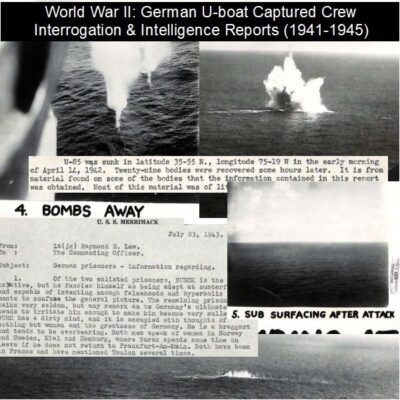
World War II: German U-boat Captured Crew Interrogation & Intelligence Reports (1941-1945)
$19.50 Add to Cart -
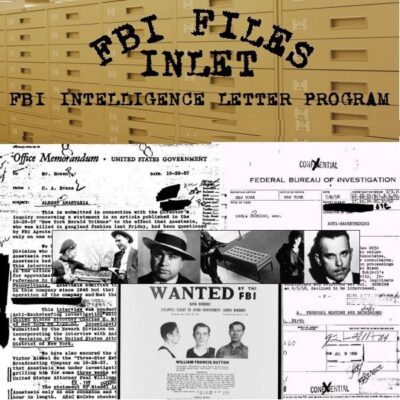
FBI/Nixon Intelligence Letter Program (INLET)
$9.90 Add to Cart -
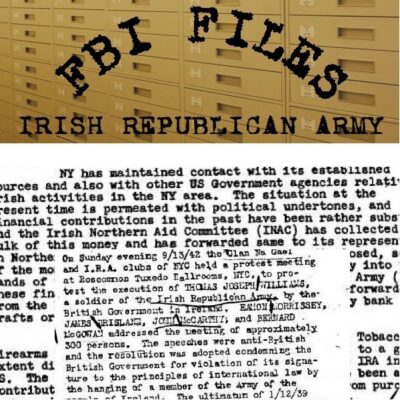
Irish Republican Army (IRA) FBI Files
$19.50 Add to Cart -
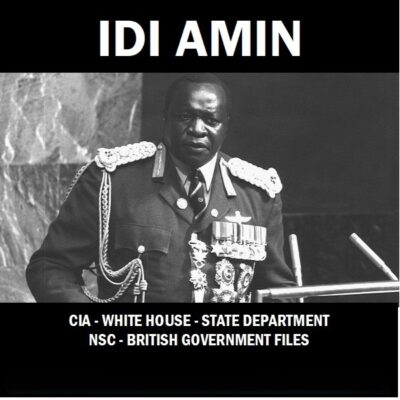
Idi Amin White House – State Department – NSC – CIA – British Government Files
$19.50 Add to Cart